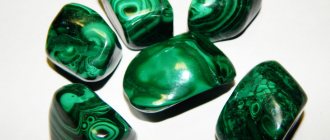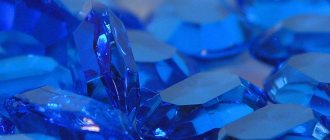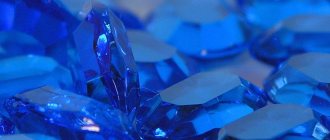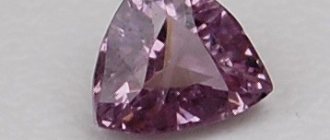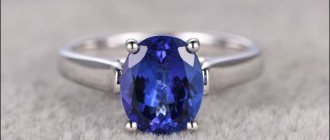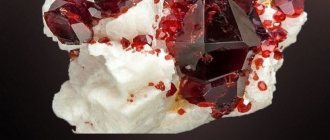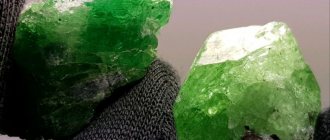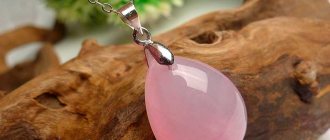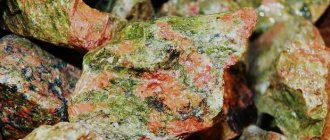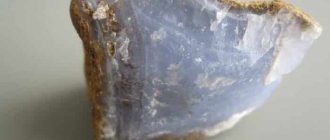It would seem that most geological discoveries were made in ancient times, when the first scientists described various minerals and their properties. It is clear that the idea of materials could change over time, with the advent of new analysis techniques and specialized equipment. But precisely the probability of discovering a new stone in the relatively recent past should not have been particularly high.
But Francois Beudan, who discovered spessartine and described it in 1832, had a slightly different point of view. The mineral received its unique name thanks to the plateau of the same name, located in Bavaria. It was here, on the alpine peaks, that crystals of a hitherto unknown variety of garnet were found.
For almost half a century, geologists believed that only the Alps could boast such a rare stone. But after years of searching, it was found that spessartine is somewhat more common, and the geography of its finds is very extensive. Starting from the most remote New Zealand and ending with hot Brazil.
What is spessartine?
Special attention should be paid to the appearance of the stones. It’s worth saying right away that there is a completely coherent scientific explanation for the phenomenon - coloring is ensured by impregnation with aluminum and manganese ions, which can give a whole range of shades. Starting from a rather exotic yellow-pink color and ending with a red-brown color.
The stone itself is translucent, but its structure contains bubbles - forever frozen air and gas. Thanks to such a heterogeneous structure, the output we get is a special refraction of light rays and really bright and rich colors.
It’s especially disappointing when the rarest stone simply cannot be used for jewelry. We are talking about dark brown, completely opaque minerals that lose all their attractiveness. And the reason is quite banal - iron ions, which lead to such consequences.
But beauty is a very changeable concept. For example, in Afghanistan and Pakistan, dark red stones are mined, which look great and are valued by the most famous jewelers.
There is also a honey yellow color that is extremely difficult to find. Combined with excellent external data, this makes such minerals especially valuable. But even they are not the rarest and most interesting variety.
How to spot a fake
When cut, orange garnet can be confused with similar-looking types of titanite, tourmaline and zircon. Also, spessartine itself is often confused with almandine, andradite and grossular, since all these varieties of garnet can be found in the same shades. It is impossible to visually distinguish specimens, so laboratory methods are used for testing. Sometimes a rare gem is sold as oolongite, which is a Swiss synthetic material similar in structure and properties to garnet.
Spessartine is an expensive stone . An insert of this mineral weighing 1 carat is estimated at $60-100. A cut gem weighing 3-5 carats sells for $150 per carat. Large specimens over 10 carats, with exclusive color characteristics, can be more expensive than gold. The most valuable garnets are those mined in Nigeria. They are distinguished by a rich orange-yellow hue and a high cost of 800-1000 dollars per carat.
If a store seller offers spessartine at a lower price, then it is a fake.
Tangerine pomegranate
A century and a half after the discovery and description of spessartine, a vein was found that was considered unique for some time. We are talking about bright orange stones, called “tangerine garnet”. The first and, for several years, only source was a small mine in South Africa, which dramatically increased its capitalization.
But later it turned out that, again, the stone is distributed somewhat more widely than one might have expected at first glance. The developments of Madagascar and Tanzania acted as new sources. The latest find is currently only 10 years old.
As for prices, the cost of stones is comparable to the price of emeralds and topazes. And when you consider that in many cases their weight exceeds 5 carats, it only becomes more interesting.
Color spectrum
The color of spessartine ranges from yellow to blood-red, closer to ruby, shades. Brown specimens are also found in nature.
The rarest, and therefore the most valuable, specimens are dark orange.
There are several varieties of spessartine:
- Mandarin - got its name because of its bright color. It was discovered in the middle of the last century.
- Epessandite is a honey-brown gemstone. Not very attractive in appearance.
- Fireball is another variety of garnet that is similar in color to a honeycomb but has a less distinct shape.
Spessartine and the jewelry industry
Despite all the qualities described above, spessartine is not often seen as an element of any jewelry. And there are a number of reasons for this that force jewelers to refuse to process such material.
The fragility of the mineral is one of the main reasons. The thing is that even a visual inspection does not always guarantee the correct conclusion. The slightest microcracks, almost always present, make the structure unstable under any mechanical influence. And even the best tools and cutters will not help in this matter.
But even if you managed to cut the stone, it’s too early to rejoice. After all, ahead of the master lies grinding, during which the mineral may simply collapse, already at the last stage. It is extremely difficult to find spessartine without any flaws; it is truly a unique material.
Tourmaline and topaz are just the beginning of the list of gems that spessartine can imitate. Only a professional will find the differences; these materials are very easy to confuse with the naked eye, which demonstrates the high quality of jewelry.
We check for authenticity
Untreated spessartine is more difficult to confuse with other minerals than cut spessartine. If you put orange spessartine, tourmaline and zircon in front of an ordinary buyer, he is unlikely to figure out which is which.
Sellers shamelessly take advantage of the similarity of stones, selling cheaper minerals under the guise of more expensive ones.
How to avoid this:
- Weigh the crystal in your palm. Natural spessartine cannot weigh as much as a feather - that’s what plastic imitations weigh.
- Pay attention to the sensations. Natural stones remain cool for a long time. Unless, of course, they were traded directly under the sun.
- Consider the decoration. There should be no scratches or too sharp color changes on it. Smooth color transitions are characteristic of natural gems.
When buying very expensive jewelry, it is better not to take risks and contact a specialist. Having examined the product, he will be able to accurately pronounce a verdict - whether it is a fake or not.
What types of stones are there?
Mineral deposits can be of different nature, depending on the geological features of the area. Very often you have to deal with veins, inclusions and crystalline crusts. Much less often we talk about druses, in which the material is located together with other stones. Quartz, mica and fluorite can act as “accompanying” materials. Less commonly - rutile and magnetite. Mica, by the way, was previously used for glazing windows. The result was a cloudy layer with occasional inclusions of precious stones.
Due to the fact that stones are most often found as inclusions and veins, problems arise with their extraction. If a deposit of any ores is developed using explosions, this guarantees the destruction of gems that are really worth attention. They simply will not withstand the existing loads, which will lead to the destruction of their structure.
And even if they could withstand it, no one would waste time on prospecting and filtering the material, because in most cases, employees are interested in extracting a specific ore, and everything else just goes to waste. As a result, we are losing a huge number of truly worthwhile samples.
Physico-chemical characteristics
Spessartine is a garnet group mineral, a silicate of manganese and aluminum.
There are common cases of replacing these impurities with compounds of iron, yttrium, magnesium, vanadium, titanium (up to 3% of the composition). The dominance of any element determines the aesthetic and utilitarian parameters of spessartine.
| Color | Red, orange, red-orange, light brown, brown-red, yellowish |
| Stroke color | white |
| origin of name | location of discovery: Spessart mountain range, Bavaria (Sommer quarry, Wendelberg mountain). |
| Opening place | Sommer quarry, Wendelberg, Haibach, Aschaffenburg, Spessart, Franconia, Bavaria, Germany |
| Opening year | 1832 |
| IMA status | valid, first described before 1959 (before IMA) |
| Chemical formula | Mn3Al2[SiO4]3 |
| Shine | glass bold |
| Transparency | transparent translucent opaque |
| Cleavage | imperfect |
| Kink | conchoidal uneven |
| Hardness | 6,5 7 7,5 |
| Thermal properties | easily melts into a black non-magnetic bead. With brown and phosphorus salts in an oxidizing flame - reaction to Mn. |
| Typical impurities | Ti,Fe,Mg,Ca,H2O,Y |
| Strunz (8th edition) | 8/A.08-30 |
| Hey's CIM Ref. | 16.16.2 |
| Dana (8th edition) | 51.4.3a.3 |
| Molecular weight | 495.03 |
| Cell Options | a = 11.63Å |
| Number of formula units (Z) | 8 |
| Unit cell volume | V 1,573.04 ų |
| Point group | m3m (4/m 3 2/m) – Hexoctahedral |
| Space group | Ia3d (I41/a 3 2/d) |
| Density (calculated) | 4.19 |
| Density (measured) | 4.12 – 4.32 |
| Type | isotropic |
| Selection form | well-formed rhombododecahedral, tetragontrioctahedral, sometimes tabular (110) crystals, confluent masses, interspersed grains, crusts, druses. |
| Classes on taxonomy of the USSR | Silicates |
| IMA classes | Silicates |
| singonia | cubic |
| Fragility | Yes |
The mineral is vulnerable to heat, prone to cracking, and has small dimensions.
The color range of spessartines ranges from pale orange to red through red and dark orange.
Techniques for mining gems
The process can be described in two words – extremely carefully. Indeed, great attention is paid to planning and searching for possible veins and veins. After all, the use of any explosives is simply unacceptable; this will lead to the loss of all valuable gems.
Is there any alternative? Of course, painstaking calculations and minimal influences allow you to find truly interesting stones. For example, special attention is paid to this process in the mountainous regions of the USA and China. It is from the largest country in the world in terms of population that we receive the most interesting specimens that can completely absorb the attention of both domestic and foreign collectors.
Rocks in which spessartine can be found
Our region cannot yet boast of discovered deposits of this mineral. But, purely theoretically, it should be in large quantities in Kamchatka. This is supported by the presence of other types of garnet and rare earth metals. Another argument in favor is volcanic activity and ancient disasters, which are a kind of marker of the presence of spessartine.
If we are talking about mining in the interests of the jewelry industry, no, there is no such experience. Considering the small number of cores and the peculiarities of their development. But the gems mined in the Middle Urals and Karelia are of real interest to private collectors and state museums.
origin of name
The mineral is named after the area of Spessart in Bavaria (Bedan, 1832).
Synonyms: Manganese-aluminum garnet - manganese-aluminum garnet, Manganongranat, Broddbogranat (Berzelius, 1816), manganese garnet - manganesian garnet (Seibert, 1823), partschin - partschin (Haidinger, 1847), partschinite, parchinite - partschinite (Dana, 1892, name excluded by Zedlitz, 1933), spessartite - spessartite (Dana, 1892), brownstone flint - Braunsteinkiesel (Carsten, 1800), emildine - Spessartine, containing Y (according to spectral analysis) (Vander- Lingen, 1928), erinadine - erinadine - spessartine containing Y and Cr (according to spectral analysis) (Van der Lingen, 1928), ferro-calcium-(Fe-Ca-) Spessartine - Fe-Ca-spessartine, calcioferro -(Ca-Fe-)-spessartine - Ca-Fe-spessartine - enriched with Fe2+, Ca or Ca and Fe2+ (Yoshimura, 1939), calc-spessartite - enriched with Ca (Fermor, 1926), ferrospessartite - ferrospessartite - enriched with Fe2+ (Fermor, 1928), beryllium garnet - spessartine containing 0.39% BeO (Iimori, 1938). Bodenbenderite - bodenbenderite' (Riemann, 1928) - a mixture with fluorite, chlorite and others (Milton and Myers, 1949). Ransetite - ransatite (Igelström, 1896) - a mixture with quartz, pyrophyllite, chloritoid, kyanite (Weibul, 1898). Johnstonotite - johnstonotite, otherwise johnstonolite - johnstonoiite (McLeod, White, 1900) according to Ford (1967) - a mixture of spessartine, grossular and other minerals.
Open gem deposits
We are talking about a mineral that consists of multiple inclusions in granite. And it just so happens that gems are much denser than this massive material, which allows them to simply wait. Sometimes it takes millions of years to wait, but it's worth it. After all, ultimately, thanks to erosion and aggressive environmental factors, granite is destroyed and spessartine simply comes out to freedom, ending up on the surface in the form of wonderful placers, for the extraction of which a banal garden shovel is enough.
At the moment, only one such placer has been discovered in the world, which is located on the shores of the Pacific Ocean and invariably attracts tourists and adventurers.
Purple Beach
In fact, this is not the fevered imagination of a cartoonist, but a real place in California, in one of the national parks. The thing is that in the immediate vicinity of the beach there are granite mountains that have experienced all the peculiarities of erosion for many millennia. This led to their partial destruction and the loss of tiny particles of spessartine, which were enclosed in the massive shell of the mountain.
The indigenous Indians already had legends and beliefs about this place, which was rightfully considered special and even sacred. It was used for negotiations and concluding peace treaties.
Don't forget about the refraction of rays. Just imagine, a whole beach strewn with countless grains of spessartine sand, in each of which the sunset or dawn sun is refracted. This is guaranteed to be a view worth checking out.
Another interesting point is the inconstancy of the picture. The main factor is sunlight; the angle of incidence of the rays depends on the location of the luminary. The lower it is to the ground, the more often spessartine changes its color, showing a real show for tourists.
And don’t forget about the wind and waves, which constantly change the pattern of the beach, creating truly unique compositions that would be the envy of many impressionists.
If you are interested in the topic of amazing beaches, you can tell a lot more about this. After all, the geology of our planet is always capable of surprising. Processes occurring over many millions of years can lead to truly amazing results.
Probably, no one will be surprised by the black beach formed as a result of volcanic activity. But the green one, made from peridot crystals, can please the eyes of many tourists. This attraction is located in Hawaii.
Name connection
Based on centuries-old practical experience, the connection between spessartine and names has been established. It looks like this:
- The orange mineral will have harmony with the name of Julia, Angela, Anna, Camilla. Many male names are also combined with this mineral. Pavel and Svyatoslav can purchase the stone.
- The red-brown gem is recommended for Tatyans, Zinaids, Vladimirs and Konstantin.
- The red mineral can be worn by Sofia, Alexandra, Lisa, Alina, Katerina, Alla, Dasha, Valeria, Galina and Victoria. The red mineral is suitable for Arkady, Yuri, Boris, Eduard, Kirill, Philip, Maxim, Stanislav, Nikolai, Semyon and Oleg.
Interesting Facts
There is a lot to be said about spessartine. Some facts about this stone are very interesting:
- Evidence has been found that the minerals were used in ancient Anglo-Saxon and Celtic jewelry.
- The plastron of the High Priest was decorated with fiery spessartine. The symbol of the conqueror was attributed to him.
- There is an opinion that Don Juan's ring was inlaid with a sparkling, fiery manganese garnet.
- The legend of Noah's Ark says that a scarlet carbuncle was placed in the middle of the structure to disperse light.
- Modern Greeks claim that their ancestors wore a rare “torch stone” around their necks, which improved visibility at night.
Spessartine and the zodiac constellations
By the time spessartine became known to the majority, astrology had already been formed a long time ago, which created certain difficulties for the formation of a general opinion. As a result, the idea of who this stone is most suitable for can vary greatly, depending on the specific school of astrologers.
It's really funny how the different variations don't even overlap. Some, for example, believe that the stone is ideal for Aquarius, Sagittarius and Scorpio. But others advise Pisces, Libra and Cancer to purchase jewelry with such a gem. In any case, most astrologers agree that this is a stone of love and positivity.
Artificial production of the mineral.
For the first time, the mineral was obtained in a mixture with tephroite and rhodonite by fusing “white clay” with excess MnCl2 in the presence of water vapor and hydrogen. Synthesized by heating a mixture of SiO2, AlO3, Fe and Mn carbonates (in appropriate proportions) to 500° at a pressure of 500 and 1000 kg/cm2; the addition of Na2SiF6 contributed to an increase in crystal size. From a mixture of Al2O3-3H2O and 3SiO2-H2O with the addition of MnCO3 it can be obtained at a pressure of 200 to 1500 atm and a temperature of 410°; with the addition of Fe carbonate or oxalate, spessartine with an admixture of the almandine component is obtained (at temperatures up to 500°), and with the addition of MgF2, spessartine with an admixture of the pyrope component is obtained (at 390-400°). From a mixture of SiO2, Al(OH)3, Al (NO3)3 - 6H2O and MnO2 Spessartine was obtained at 900°C and a pressure of 10,000 atm. The mineral is not formed in alkaline solutions.
Diagnostic signs
The mineral is easily identified by its external characteristics: the characteristic appearance of the crystals, greasy luster, high hardness and relatively high specific gravity.
Satellites.
Topaz, tourmaline, beryl, fluorite, bustomite, rhodonite, hausmannite
The magical properties of spessartine
With magical performances the situation is much the same, due to a relatively recent discovery. But humanity has known about pomegranate for a very long time, and the Middle Ages are full of superstitious statements about this mineral. For example, it was he who was supposed to scare away demons and other evil spirits from the owner.
And with his help, one could count on a fair decision. To do this, it was enough for the judge to drink water with a ground stone to receive insight from above. You can find many treatises on similar topics.
Talismans, amulets
Spessartine garnet
Spessartine is credited with masculine energy, so it can only be used as a talisman or amulet by people with qualities such as willpower, assertiveness and self-confidence.
A spessartine amulet is necessary for people whose profession involves quick response, danger and life risks. These are rescuers, athletes, racing drivers, stuntmen.
A talisman with a stone helps businessmen. His energy is focused on expanding business and increasing profits. The stone will highlight the leaders of large companies as leaders in the team.
Red spessartine is rightly called the amulet of love. It is believed that it enhances the attractiveness and attractiveness of its owner, captivating the views of the opposite sex.
